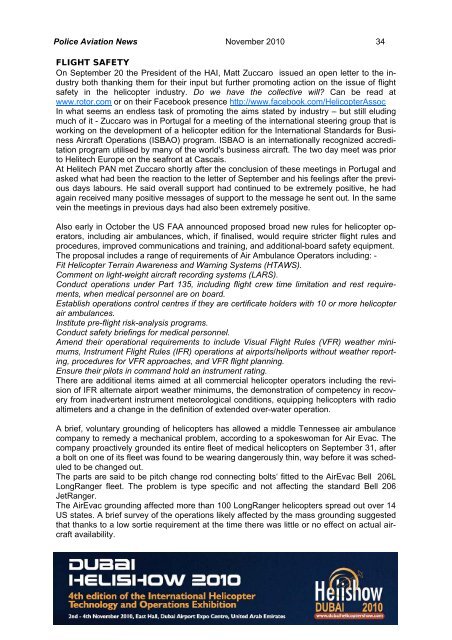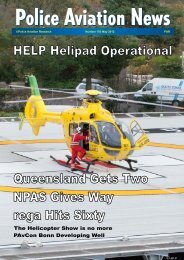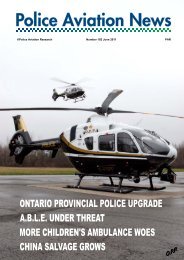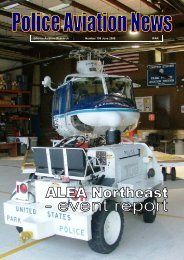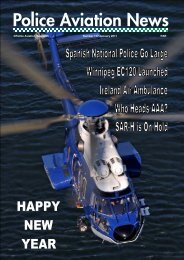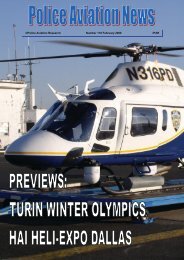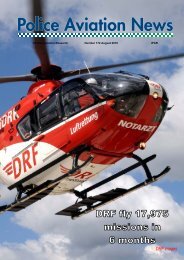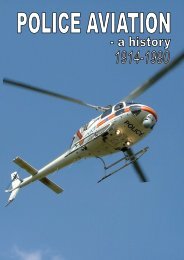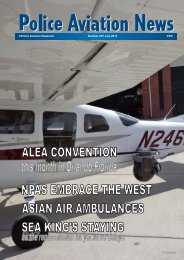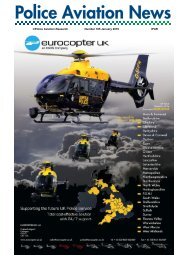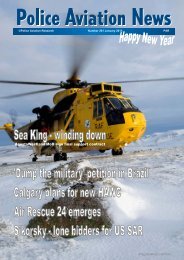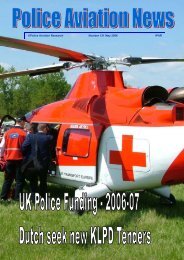Police Aviation News November 2010
Police Aviation News November 2010
Police Aviation News November 2010
Create successful ePaper yourself
Turn your PDF publications into a flip-book with our unique Google optimized e-Paper software.
<strong>Police</strong> <strong>Aviation</strong> <strong>News</strong> <strong>November</strong> <strong>2010</strong> 34<br />
FLIGHT SAFETY<br />
On September 20 the President of the HAI, Matt Zuccaro issued an open letter to the industry<br />
both thanking them for their input but further promoting action on the issue of flight<br />
safety in the helicopter industry. Do we have the collective will? Can be read at<br />
www.rotor.com or on their Facebook presence http://www.facebook.com/HelicopterAssoc<br />
In what seems an endless task of promoting the aims stated by industry – but still eluding<br />
much of it - Zuccaro was in Portugal for a meeting of the international steering group that is<br />
working on the development of a helicopter edition for the International Standards for Business<br />
Aircraft Operations (ISBAO) program. ISBAO is an internationally recognized accreditation<br />
program utilised by many of the world's business aircraft. The two day meet was prior<br />
to Helitech Europe on the seafront at Cascais.<br />
At Helitech PAN met Zuccaro shortly after the conclusion of these meetings in Portugal and<br />
asked what had been the reaction to the letter of September and his feelings after the previous<br />
days labours. He said overall support had continued to be extremely positive, he had<br />
again received many positive messages of support to the message he sent out. In the same<br />
vein the meetings in previous days had also been extremely positive.<br />
Also early in October the US FAA announced proposed broad new rules for helicopter operators,<br />
including air ambulances, which, if finalised, would require stricter flight rules and<br />
procedures, improved communications and training, and additional-board safety equipment.<br />
The proposal includes a range of requirements of Air Ambulance Operators including: -<br />
Fit Helicopter Terrain Awareness and Warning Systems (HTAWS).<br />
Comment on light-weight aircraft recording systems (LARS).<br />
Conduct operations under Part 135, including flight crew time limitation and rest requirements,<br />
when medical personnel are on board.<br />
Establish operations control centres if they are certificate holders with 10 or more helicopter<br />
air ambulances.<br />
Institute pre-flight risk-analysis programs.<br />
Conduct safety briefings for medical personnel.<br />
Amend their operational requirements to include Visual Flight Rules (VFR) weather minimums,<br />
Instrument Flight Rules (IFR) operations at airports/heliports without weather reporting,<br />
procedures for VFR approaches, and VFR flight planning.<br />
Ensure their pilots in command hold an instrument rating.<br />
There are additional items aimed at all commercial helicopter operators including the revision<br />
of IFR alternate airport weather minimums, the demonstration of competency in recovery<br />
from inadvertent instrument meteorological conditions, equipping helicopters with radio<br />
altimeters and a change in the definition of extended over-water operation.<br />
A brief, voluntary grounding of helicopters has allowed a middle Tennessee air ambulance<br />
company to remedy a mechanical problem, according to a spokeswoman for Air Evac. The<br />
company proactively grounded its entire fleet of medical helicopters on September 31, after<br />
a bolt on one of its fleet was found to be wearing dangerously thin, way before it was scheduled<br />
to be changed out.<br />
The parts are said to be pitch change rod connecting bolts‘ fitted to the AirEvac Bell 206L<br />
LongRanger fleet. The problem is type specific and not affecting the standard Bell 206<br />
JetRanger.<br />
The AirEvac grounding affected more than 100 LongRanger helicopters spread out over 14<br />
US states. A brief survey of the operations likely affected by the mass grounding suggested<br />
that thanks to a low sortie requirement at the time there was little or no effect on actual aircraft<br />
availability.


